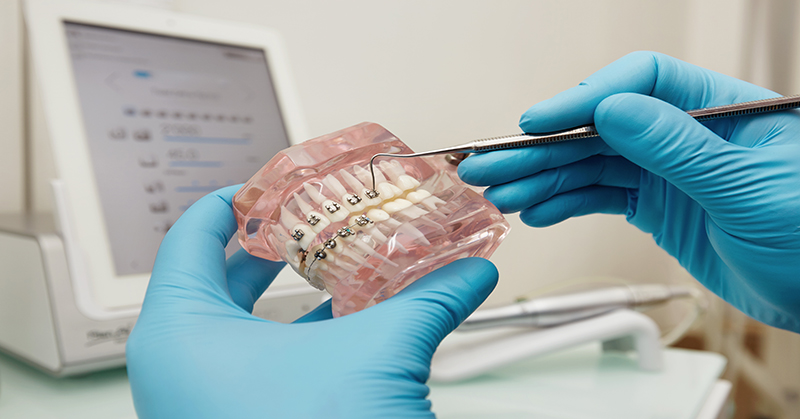What Are the Possible Risk Or Side Effects for Dental Implants?
Dental implants provide an excellent way to replace missing teeth and restore your smile. But as with any medical procedure, there are possible risks and side effects to consider before undergoing implant surgery. In this article, we aim to provide a comprehensive overview of dental implants - what they are, who is a suitable candidate, and most importantly, the potential risks and complications that can arise. By understanding both the benefits and possible downsides of implants, you can make a fully informed decision about whether they are the right choice for your individual needs and health profile.Invisalign Or Braces? Which Is Better?
updated on November 15, 2023
Getting the smile you've always dreamed of often requires straightening your teeth. Orthodontic treatments like braces and Invisalign are two popular options for realigning crooked, gapped, or mispositioned teeth. But how do you choose between metal braces and almost invisible aligners?
In this article, we'll overview braces versus Invisalign so you can make an informed decision about the best treatment for your needs. We'll explain how both orthodontic appliances work to move teeth and discuss the pros and cons of each. You'll learn key differences between braces and Invisalign when it comes to appearance, comfort, effectiveness, and cost. With a strong understanding of both treatments, you'll be equipped to have a discussion with your orthodontist and select the ideal straightening method for your unique smile goals and lifestyle. Read on for the important details you need to make this key choice!
What Are Braces?
Braces are popular orthodontic appliances that utilize brackets bonded to the teeth which are then connected by archwires to apply constant gentle pressure and slowly shift teeth into proper alignment over time. The two most common types of braces are metal and ceramic. Metal braces have stainless steel brackets and wires for a traditional look. Ceramic braces feature tooth-colored or clear ceramic brackets for a more discreet aesthetic.
Regardless of type, small elastic bands or built-in clip doors are used to hold the archwire firmly to each bracket as tension is applied. Braces rely on the gradual force of the wires to move teeth based on the treatment plan created through proper imaging and examination by an orthodontist.
In addition to metal and ceramic options, there are also less common types of braces such as lingual and self-ligating braces. Lingual braces have the brackets and wires attached to the back of the teeth rather than the front. This hides them from view but can cause more discomfort on the tongue side of the mouth. Self-ligating braces are similar to metal/ceramic but have built-in covers to connect the wires instead of removable rubber bands.
What is Invisalign?
Invisalign consists of smooth, transparent plastic aligners that fit over teeth like removable retainers. Aligners are custom-made in a series to match each projected stage of tooth movement progression. Treatment starts with an impression or 3D scan of the patient’s teeth to map out the existing alignment. Advanced software generates a digital simulation of how teeth are expected to incrementally shift with each successive aligner.
Each aligner applies light force to gently nudge the teeth toward the position predicted for that specific stage. Patients switch to the next aligner in the series every 1-2 weeks as teeth gradually shift into place. New aligners are given until the desired final alignment is achieved.
Pros and Cons for Braces vs. Invisalign
As covered previously, braces and Invisalign work differently to achieve teeth straightening, each with their own advantages and disadvantages. Examining the pros and cons of both methods can help patients make the best choice for their needs.
A major pro of Invisalign is the clear, removable plastic aligners, which are more aesthetically pleasing than conspicuous metal braces. Invisalign is also gentler and less painful during treatment. Aligners can be taken out for normal brushing, flossing and eating, facilitating better hygiene and dietary freedom. However, Invisalign requires diligent cleaning and demands high compliance wearing aligners 22+ hours per day. It may not work as well for complex cases like impacted teeth. There is also a risk of losing aligners.
The fixed nature of braces enables application of greater force to treat more complex misalignments. Braces tend to have shorter treatment times and can achieve very precise results. Various bracket styles like clear ceramic provide aesthetic options. On the downside, traditional metal brackets are less discreet. Flossing and brushing takes more effort with braces. Patients also have to avoid certain foods to prevent damage. Monthly adjustments are required, prolonging treatment if issues like wire breaks occur.
In summary, while Invisalign offers advantages in comfort, hygiene and aesthetics, braces are better suited for complex cases needing more control over tooth movement forces. The choice depends on a patient's specific orthodontic needs and personal preferences. Thoroughly discussing the pros and cons of each method with an orthodontist is key to selecting the optimal treatment approach.
Other Orthodontic Treatment:
In addition to the two main options of braces and Invisalign, there are other orthodontic treatments that may be considerations in certain situations.
-
Rubber bands and headgear can be used in conjunction with braces when extra force is required to move teeth and jaws into the proper alignment. Patient compliance is key in wearing these appliances consistently as directed. Decorative rubber band colors and removable headgear that is only worn at night help improve compliance.
-
Retainers play a critical role post-treatment with either braces or Invisalign to hold teeth in their new corrected positions. Removable and fixed retainers made of clear or colored plastic and wires keep teeth from shifting. Consistent retainer wear is crucial during the settling period after appliances are removed.
For patients seeking to improve smile aesthetics without full orthodontic realignment, dental veneers may be an alternative to consider instead of braces or Invisalign. Veneers are thin porcelain covers bonded to the front of teeth to mask spacing or imperfections and create a straightened appearance. However, veneers do not move or rotate teeth like orthodontic appliances.
So, working closely with an orthodontist is the best way to determine which treatment or combination of approaches will provide the desired functional and cosmetic improvements.
-

free&low-cost dental clinics
View Now
dental health

Dental Implants

Dental Implants
Why Are Implants So Expensive?
According to recent statistics, tooth loss is a prevalent issue, especially among older individuals. Adults between the ages of 20 to 64 have an average of 25.5 remaining teeth. However, factors such as age, smoking, lower income, and education level can contribute to a higher likelihood of tooth loss. In this article, we will explore dental implants in detail through the following aspects:
Dental Implants
Top Dental Implant Brands in the United States
When it comes to dental implants, finding a reputable and reliable dental implant service is crucial. Dental implants are a popular and effective solution for replacing missing teeth, providing individuals with improved aesthetics, functionality, and oral health.With the increase in demand for dental implants, numerous brands have emerged, providing a variety of options to meet the diverse needs and budgets of patients. Choosing the right dental implant brand is vital as it directly affects the success and longevity of the dental implant procedure. In this article, we will explore some of the top dental implant brands in the United States, known for their expertise, advanced technology, and exceptional patient care.
Dental Implants
Will Your Insurance Cover Dental Implants?
Dental implants are growing in popularity, with over 3 million Americans choosing them to replace missing teeth. While implants fuse securely into the jawbone providing natural-looking and long-lasting tooth replacements, the process does come with a hefty price tag. On average, a single implant can cost $1,600-$2,200 out of pocket. For patients needing multiple implants or other restorative work, these expenses quickly add up.
Dental Implants
How Painful is Dental Implant Surgery?
If you are missing teeth due to decay, injury, or gum disease, dental implants offer an effective and natural-looking replacement option. Unlike removable dentures that can slip, implants fuse securely into your jawbone for permanent stability. They also help preserve bone and support surrounding teeth better than bridges or dentures. But most patients wonder - how painful are implants? The procedure does involve surgery and recovery time.
Dental Implants
Do You Know All These Different Types of Implants?
In the field of dentistry, dental implants have revolutionized the way we approach tooth replacement. With their durability, functionality, and aesthetic appeal, dental implants have become the go-to solution for individuals with missing teeth. However, not all dental implants are created equal. There are various types of dental implants, each with its own unique characteristics and applications. In this comprehensive guide, we will explore the different types of dental implants and the techniques used for their placement.







